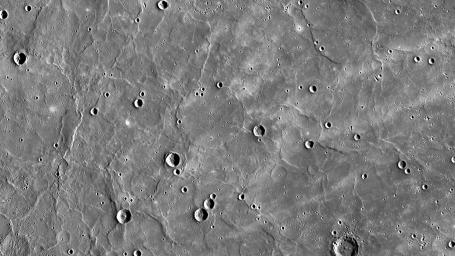
|
Expansive Northern Volcanic Plains
- Click the image above for a larger view
- Full-Res JPEG (1920 x 1080) (705.6 kB)
- Full-Res TIFF (1920 x 1080) (2.1 MB)
Caption:
Mercury's northern region is dominated by expansive smooth plains, created by huge amounts of volcanic material flooding across Mercury's surface in the past. The volcanic lava flows buried craters, leaving only traces of their rims visible. Such craters are called ghost craters , and there are many visible in this image, including a large one near the center. Wrinkle ridges cross this scene and small troughs are visible regionally within ghost craters, formed as a result of the lava cooling . The northern plains are often described as smooth since their surface has fewer impact craters and thus has been less battered by such events. This indicates that these volcanic plains are younger than Mercury's rougher surfaces.
Instrument:
Mercury Dual Imaging System (MDIS)
Center Latitude:
60.31° N
Center Longitude:
36.87° E
Scale:
The large ghost crater at the center of the image is approximately 103 kilometers (64 miles) in diameter
Background Info:
The MESSENGER spacecraft is the first ever to orbit the planet Mercury, and the spacecraft's seven scientific instruments and radio science investigation are unraveling the history and evolution of the Solar System's innermost planet. In the mission's more than four years of orbital operations, MESSENGER has acquired over 250,000 images and extensive other data sets. MESSENGER's highly successful orbital mission is about to come to an end , as the spacecraft runs out of propellant and the force of solar gravity causes it to impact the surface of Mercury in April 2015.
For information regarding the use of images, see the MESSENGER image use policy .
Cataloging Keywords:
| Name | Value | Additional Values |
|---|---|---|
| Target | Mercury | |
| System | ||
| Target Type | Planet | |
| Mission | MESSENGER | |
| Instrument Host | MESSENGER | |
| Host Type | Orbiter | |
| Instrument | Mercury Dual Imaging System (MDIS) | |
| Detector | ||
| Extra Keywords | Crater, Grayscale, Impact, Radio, Volcano | |
| Acquisition Date | ||
| Release Date | 2015-04-16 | |
| Date in Caption | ||
| Image Credit | NASA/Johns Hopkins University Applied Physics Laboratory/Carnegie Institution of Washington | |
| Source | photojournal.jpl.nasa.gov/catalog/PIA19415 | |
| Identifier | PIA19415 | |
